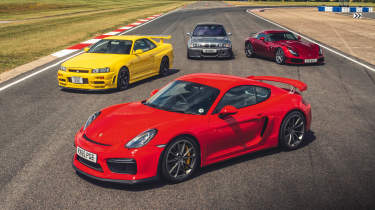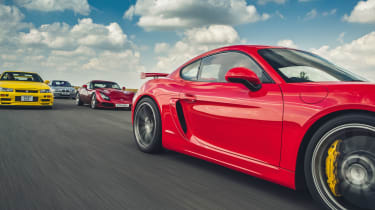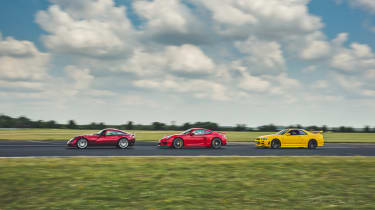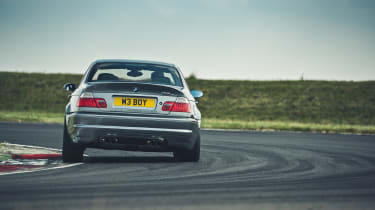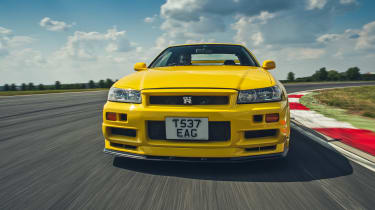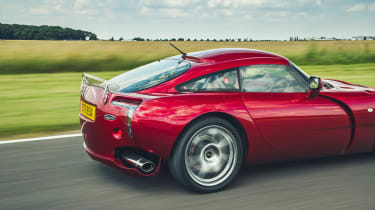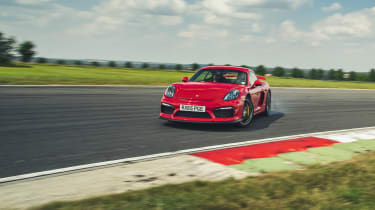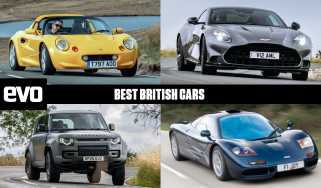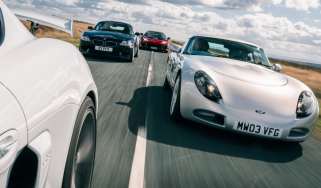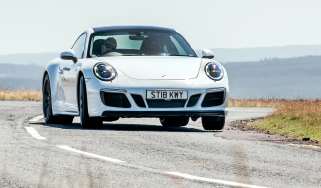BMW M3 CSL v Nissan R34 Skyline GT-R v TVR Sagaris v 981 Porsche Cayman GT4
The BMW M3 CSL, Nissan R34 Skyline GT-R, TVR Sagaris and original Porsche Cayman GT4 are all shining examples of the sports car breed. But what is the elixir that makes them so special?
Let’s at least try to keep this simple. Almost any vehicle, however hopeless, can be driven for sport. With the right mindset, feeble and flabby are merely challenges to be overcome through the agents of guile, gritted teeth and slipstreaming. For white-van drivers it appears to be a way of life, though to be fair to the overtaken, today’s tin-sided hardware can haul a bit and hardly disincentivises its eager operatives from exploiting their good fortune.
A sports car is something else. It doesn’t have to be a two-seater convertible. Nor does it matter where its engine sits in the chassis or, up to a point, how many cylinders said motor has. Not so many that it’s mistaken for a supercar, perhaps. Then again, if it’s a Porsche 911, maybe both can exist in a perfect state of superimposition.
And maybe it’s best to forget about unyielding categories and traditional metrics altogether. A sports car should be a car you want to drive purely for the selfish, indulgent, interactive hit. Not because it looks exotic and makes the neighbours’ curtains twitch. Not because, like an open-air heavy metal rock concert, you can hear it from several miles away. Destination is immaterial, passengers a distraction, luggage undesirable, a great road preferable. Power and speed are vital but don’t have to be big numbers so long as the dynamic forces balance. Feeding the senses, stimulating the physical hard points – neck muscles, hands, seat of pants, feet – are more important. Sports cars are born of elements that can be as varied as those of the periodic table and combined to produce a very specific performance chemistry.
> Nissan Skyline GT-R R34: review, history and specs of an icon
Among the four talented exponents gathered here, you won’t see a two-seater soft-top. Many would be eligible, but shape, style and seating arrangements aren’t held to be defining characteristics for this exercise. Instead, here are four cars that, in evo’s view, represent contrasting yet tightly bound facets of the sports car driving experience, and that has everything to do with what goes on behind the wheel.
By way of introduction, then, a few teasers. So immediate and so abundant is the BMW M3 CSL’s response to the throttle between 2000 and 7000rpm, so scalp-prickling its yowl and so scarce the time it takes the fully stoked SMG transmission to shift through the engine’s workload, it simply makes you feel more alive. I’ll have some of that.
Our rare, yellow, lightly breathed-on Nissan Skyline R34 GT-R V-spec’s ample power drives a chassis that shares moves with the current GT-R and, through a compelling mixture of prodigious push and adaptive all-drive chassis collusion, builds fierce cross-country pace that engages and absorbs on a cerebral as well as a physical level.
A riot of sensations, the Sagaris is a fitting way to remember TVR, and thus the kind of raw, close-coupled intensity locked into the DNA of British sports cars at their boldest and most charismatic. All the core assets are present: original style and detailing that makes most supercars look clichéd and glib; bellowing, side-firing exhaust ballistics; heavy, reference-rattling shove in any gear; a glove-snug, alloy-filleted cabin of astonishing elegance; and an honest, rear-drive chassis with heaps of grip, response and agility that’s exactly as effective – no more, no less – as the talent or otherwise behind the wheel. It’s a ‘do one thing every day that scares you’ kind of sports car.
Then there’s one of the great manual shifts – a thing of joy and satisfaction in isolation. It belongs to the Porsche Cayman GT4, a car that blends its ample attributes so seamlessly that its seduction technique is both insidious and irresistible. You get in, adjust the seat and steering and drive fast, immediately feeling in sync with the controls and the road. No surprises, no jarring distractions, just an easy flow and rhythm and stunning pace.
BMW M3 CSL (E46)
But I’ll start with the lightweight, carbon-roofed BMW. Cherished and fettled by owners almost to the point of fetishism, the E46 CSL is a drum-taut, hard-muscled object lesson in understated aesthetic warfare. Depending on who you listened to at the time, it was either BMW’s honest attempt to fully restore the M3’s track-evolved credibility after years of gradual weight gain and kit-list debauchery, or an expedient way to remove a surprising amount of cash from gullible poseurs. With the benefit of hindsight, the former proposition seems far more likely. In a very real sense, it’s the spiritual successor to the original E30 M3.
It sounds awesome. The Sport button doesn’t just sharpen the throttle but also gifts the deep-throated induction a megawatt hi‑fi makeover, thanks in no small measure to the contribution of its cool-looking carbonfibre air box. Arguably, no six-cylinder engine has ever sounded more soulful, more urgent, more meaningfully manic. Lean on that 355bhp at 7900rpm and the experience is feral, accelerative violence from low speeds choreographed by a salvo of shotgun-kick gearshifts. On its most aggressive setting, the SMG transmission is so completely ‘on it’ it’s hard not to get swept up in the hardcore intensity of it all. The finesse of today’s DCTs is out the window, racer-grade conviction right on the table. It’s brutal but it feels fabulous.
With suspension that’s firm and firmly damped yet never harsh or jarring, the CSL’s steering is a revelation, too – surprisingly light but brimming with deliciously resolved feel and not one millimetre of wasted motion. Turn and the CSL changes tack with almost telepathic alacrity. With seemingly no suspension bush compliance to blur the message, the instantly available distillation at the helm is response, precision and grip. Thumb the M Track button and, as with all the best sorted rear-drivers, chassis balance moves to the point where it rests on a broad line drawn between steering and throttle inputs. Then the CSL starts to flow at speed in a way you simply wouldn’t believe.
| Engine | In-line 6-cyl, 3246cc |
| Power | 355bhp @ 7900rpm |
| Torque | 273lb ft @ 4900rpm |
| Weight | 1385kg |
| Power-to-weight | 260bhp/ton |
| 0-62mph | 4.9sec |
| Top speed | 155mph (limited) |
| Price new | £64,451 (2003) |
| Value today | £39,000-80,000 |
Nissan Skyline GT-R V-spec (R34)
The techno-inflected Nissan could hardly provide a starker counterpoint to the M3 CSL’s pure, bare-knuckled fighting style. This is a more pliable, softer-edged, sonically subdued way of doing things but no less effective or rewarding for that. Arguments abound as to which is the most covetable generation of Skyline GT-R and the R34 has plenty of backers. It isn’t hard to see why. Leaner than the slightly chubby R33 and aesthetically closer to the standard-setting R32, mad outputs could still be extracted from its surely conservatively rated 276bhp RB26DETT twin-turbo, 2.6-litre straight-six. However, they tended to stay, initially at least, within sane boundaries defined by the imperative to embarrass the supercars of 20 years ago, unlike the loony tunes hypercar-hunting R35s of today.
Our V-spec example has been treated to a relatively mild ECU remap, lifting peak power to just shy of 400bhp – enough in a car weighing 1560kg to feel properly fast when the turbos are up to speed, but not plain nutty. Certainly, it’s nothing the ATTESA four-wheel drive, Super HICAS four-wheel steering and 245/40 R18 Dunlop-shod 18-inch alloys needs to work up a sweat about. And yet the R34 never feels smothered by the weight and spread of its technical ingenuity. In fact, the chassis’ kinetics are remarkably loose-limbed and mobile, while the car’s overall dynamic demeanour exhibits at least two distinctly old-school traits. One is the engine’s low-rev lethargy before the turbos go to work. Below 3000rpm in the higher gears it feels slugged and sleepy, and you can articulate your right ankle all you like – nothing much will happen. The other is the chassis’ tendency to tramline and follow cambers, needing sympathetic hands to gently coerce and cajole. Neither would be acceptable in a new car but are easily forgiven here – even welcome for the way they add a little texture and tension to what is still, in absolute terms, a seriously secure and stable way to travel at speed.
But the Skyline – maybe this Skyline in particular – has smoothness and subtlety in spades and, once it hits its stride, its slightly decohered low-speed character finds its focus and, to the sighing and hissing aspirations of energised turbos feeding the creamy growl of that race-bred six, the car’s rather portly kerb weight seems to evaporate and it simply flies down the road with a naturally flowing gait that belies the calculations of its complex undercarriage beneath.
To begin with, its steering can feel a little light and soft-edged. It doesn’t have the razor-sharp turn-in of the M3. But it is functionally accurate and guides the Nissan’s bluff nose with real precision. And so well resolved is its feedback that it gives you the time and confidence to push hard. The shift action of the six-speed gearbox isn’t nearly as gnarly as might have been expected, either. I’m impressed by the car’s seemingly effortless ability to sustain a punishing pace, the way the chassis parries the road’s humps and dips, carrying speed through the trickiest of bends with calm equanimity. The longer I drive it, the more I want to drive it. The faster we go, the more fascinating it becomes. The Skyline might not cut to the chase like the M3 CSL but it has a slower burning depth of character that’s just as affecting.
| Engine | In-line 6-cyl, 2568cc, twin-turbo |
| Power | 276bhp @ 7000rpm |
| Torque | 289lb ft @ 4400rpm |
| Weight | 1560kg |
| Power-to-weight | 180bhp/ton |
| 0-62mph | 4.8sec |
| Top speed | 165mph |
| Price new | £50,000 (1999) |
| Value today | £50,000-70,000 |
TVR Sagaris
You don’t so much sit in the TVR Sagaris as wear it. Shut the door and your view of the world is cropped at just below shoulder height. From an eyeline perspective it’s more-or-less the equivalent of donning a Star Wars Stormtrooper helmet. The seats look lean but actually serve up fine support and location, and while cabin space isn’t exactly voluminous, it’s far from constraining. For all its pronounced curves and softly gleaming stylistic flourishes, there’s space to work, which is just as well because everyday experience falls well short of the mark when you fire up the TVR.
After the acidic cut of the M3’s motor and the turbo-muted growl of the GT-R’s, here’s another big-hitting six of character, but one with the weight and inevitability of a free-falling anvil. The 4-litre, 24-valve twin-cam ‘Speed Six’ develops 406bhp between 7000 and 7500rpm and 349lb ft of torque at 5000rpm, which, in a car that weighs just 1078kg, roughly equates to acceleration that will make your eyes water – at least in the moments between muscling the stubby lever of the veteran Borg-Warner T5 gearbox through its five-slotted gate.
Simple G-force is the first thing that connects. Gun it and the slam is instant and squeezes a little chuff of air from your lungs. Stand on the stoppers and the G reversal momentarily feels strong enough to pop your eyeballs from their sockets. By the standards of the present collective, it doesn’t get much more physical than this. But then the idea with the Sagaris was always to bring racer-grade sensations to the road – maybe not such a stretch given TVR’s parallel race programmes at the time. The clues aren’t hard to find. For instance, the splitter that protrudes from below the front grille, complete with winglets, might have been pinched from a GT race car. The almost reptilian serrated spine of bonnet vents and the Perspex spoiler arcing across the boot smack of race prototype, likewise the undertray that supports the twin, sideways-mounted and side-exiting silencers and tailpipes. Suspension is comparably race-flavoured, too, with double wishbones at each end and coilover dampers. Naturally, there’s a limited-slip differential.
Mighty and thrilling as the TVR’s sheer straight-line shove is, its secret weapon is its chassis. Quick-helmed, grippy and yet remarkably poised, it’s actually less sensitive to road camber changes under braking than that of the T350 it’s based on – and less physical effort is required to hustle it along a poorly surfaced country road. Yet the ride, although uncompromisingly firm and ‘more obvious’, hasn’t fallen apart. As with the Skyline, there’s a degree of sensitivity to ridges and sudden changes in the contour of the road surface but, unlike the big Nissan, it’s best not to be too forceful guiding it back on course. Rather, relax your grip on the steering and let the Sagaris settle. Tense up and so will the TVR.
| Engine | In-line 6-cyl, 3996cc |
| Power | 406bhp @ 7000-7500rpm |
| Torque | 349lb ft @ 5000rpm |
| Weight | 1078kg |
| Power-to-weight | 383bhp/ton |
| 0-62mph | 3.7sec |
| Top speed | 185mph |
| Price new | £49,995 (2005) |
| Value today | £67,000-98,000 |
Porsche Cayman GT4 (981)
It’s a fine line between getting within a gnat’s whisker of the optimum and overshooting it, and this is something the Porsche knows all about. There’s no way those technicians and test drivers at Zuffenhausen tasked with replacing what many, including evo, believed to be Porsche’s finest driving machine couldn’t have fretted about their task. It transpires that the new GT4 is every bit as special as we might have hoped, but the blueprint for raising the Cayman’s game was applied to the previous-generation car, itself a significant advance on the original Cayman.
Lighter, lower, faster and more efficient, it didn’t just look a whole lot better than the older model, the 981 Cayman’s body was 40 per cent stiffer, the front and rear tracks 40mm and 18mm wider respectively, and the wheelbase 60mm longer. Yet it weighed 25 or 35kg less (depending whether you picked the manual or PDK option). There were more 911-esque layers of optional tech, including Porsche Torque Vectoring (PTV) and the Sport Chrono Package that added dynamic transmission mounts (like the 911’s dynamic engine mounts, but for the transmission, as that was the most rearward lump in the Cayman). Also optional was the sports exhaust, stop/start and, more controversially, electro-mechanical power steering.
If you’d never been a fan of the Cayman’s slightly awkward and effete styling, the GT4 had some thoughts on that. Shades of 911 GT3 added welcome aggression to the package – something the old-gen Cayman R singularly failed to do. The GT4’s 20-inch alloy rims, for example, were dead ringers for those on the 911 GT3, while the deeper front splitter gave the front end more of a jawline. No more subtle were the aero wing sprouting from the rear deck on delicately wrought supports, the larger side intakes to scoop in more cooling air for the 3.8-litre engine, and the rear diffuser, which stretched nearly the full width of the rear apron and concealed a pair of centrally mounted tailpipes.
With engine capacity swollen from 3.4 to 3.8 litres (essentially the 911 Carrera S’s Powerkit motor) and kilos carved from the kerb weight, the GT4’s 4.4sec 0-62mph time and 183mph top speed made it the swiftest Porsche sports car this side of a 911. The GT4 also offered a step change in agility and fluency. Fitted with the 911 GT3’s heavily uprated adjustable front axle and wearing sticky Michelin Pilot Sport Cup 2s, it came close to mid-engined perfection. The years may have rolled on, but that hasn’t changed. With more grip, bite and helm acuity but, amazingly, very little corruption in ride suppleness, even though it’s mated with still firmer body control, the Cayman GT4 gets it all right. Traction is exemplary, and the chassis is especially gifted in communicating small but critical dynamic cues. Establishing a feel for the point of balance seems almost absurdly easy and natural and immediately inspires huge confidence. The car scythes through challenging ess-bends with frankly amazing speed and precision – as extreme and addictive as you could want.
There is the merest trace of stabilising understeer on initial turn-in – deliberately built into the chassis rather than being a shortfall of grip – but there’s so much agility and adjustability that you can trim it out by trail-braking, or otherwise ride it out for a fraction of a second until you reach the apex, then neutralise the car on the throttle. It is this level of engagement that driving enthusiasts live for.
Although presumably anathema to Olympic-level heel-and-toe downshift competitors, the automatic throttle blip actually works well and is particularly helpful when the corners come thick and fast. But for those who hate the idea of a computer rev-matching for them, disengage Sport mode and the function disappears. And that’s all that changes: Sport mode affects nothing else.
Perhaps the GT4’s greatest asset – the quality that sets it apart from its sports car peers assembled here – is its fabulous cohesion. The others are pumped with elements of the DNA we look for in a sports car, but only the GT4 melds them all together seriously. The steering’s accuracy and feel, the huge mechanical grip, the finely judged damping and the vibrant top-end energy of the gem-like flat-six harmonise in a deeply satisfying fashion. The cars in this group are all talented practitioners of jaw-slackening point-to-point pace, but none amasses serious speed on any kind of road with the same polished fusion of control, consistency of grip and benign adjustability around a resolutely neutral balance as the Porsche. It’s uncanny. The way the Cayman feels compact, corners with so much force and yet allows grip to bleed away with such grace and transparent progression is simply stunning. Stopping power and pedal feel are remarkable, too.
Even in 3.8 guise, the Cayman’s flat-six engine isn’t endowed with masses of low- and mid-range torque, but neither is that heady red line there for show. The engine pulls with vivid urgency as the soaring revs and the butter-slick gearchange conspire to make wringing every last one of the 380bhp a rare and exhilarating pleasure.
Sports car perfection? Both the driving position and the shaping and support of the seats nudge perfection, while ergonomics, build and finish are better even than the BMW’s. The whole car exudes a sense of total solidity, design coherence and engineering depth that eludes the other cars here. Perhaps more tellingly, it’s the one that speaks ‘sports car’ most eloquently.
| Engine | Flat-six, 3800cc |
| Power | 380bhp @ 7400rpm |
| Torque | 310lb ft @ 4750-6000rpm |
| Weight | 1340kg |
| Power-to-weight | 288bhp/ton |
| 0-62mph | 4.4sec |
| Top speed | 183mph |
| Price new | £64,451 (2015) |
| Value today | £69,000-85,000 |
